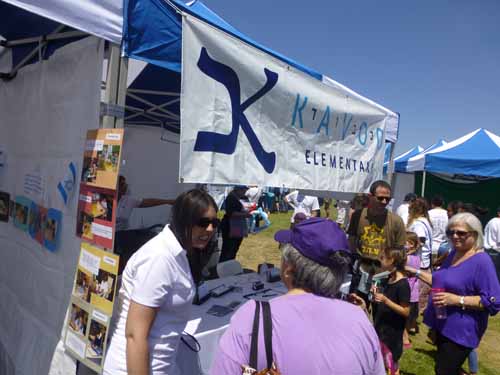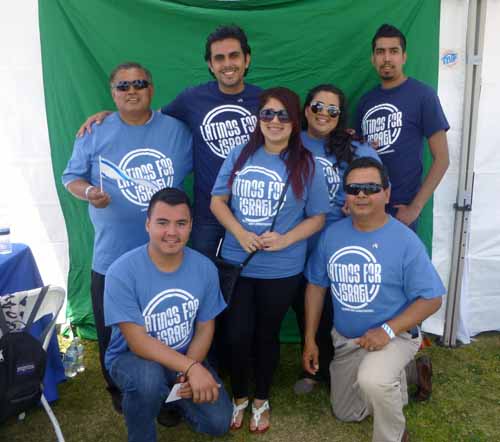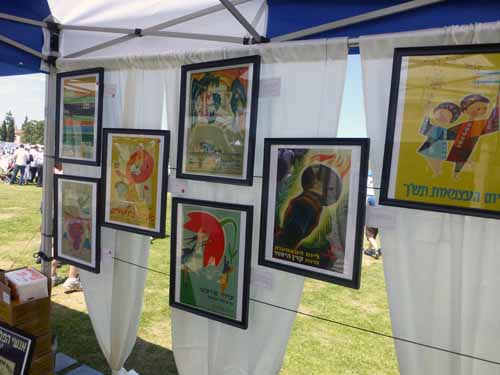
Story and photos by Donald H. Harrison
SAN DIEGO–There were so many things to do, exhibits to see, and people to schmooze with that unless you walked hand-in-hand with a companion during the entire time of the Israel Independence Festival, never letting go for even a minute, no person’s overall experiences there on Sunday, April 21, could be duplicated by another’s.
The highlights of my visit to the fair at the Nobel Recreation Center came when I heard a short welcoming speech by Mayor Bob Filner; learned about Kavod, the new Hebrew language public charter school, from its director Alexa Greenland; met Jonathan Valverde, the founder of Latinos for Israel; was amazed by Felicia Saltzbart of United Hatzalah of Israel, who told me about another way advanced Israeli technology saves lives; and browsed a poster collection, assembled by a team headed by Debbie Kornberg, recapping Israel’s history.
Introduced by Claire Ellman, chair of the Jewish Federation of San Diego, the Jewish mayor of San Diego, dressed in shirt and tie, somewhat formally for the outdoor festival, told celebrants of Israel’s 65th birthday that half his family lives in Israel. “I visit them on many occasions,” he said. “It is such a wonderful place to go and such a wonderful place to protect. We have to foster the U.S.-Israel relationship at all times because that is what keeps peace and that’s what protects Israel.” He presented a proclamation declaring the celebration to be a citywide event.

Kavod Elementary
Like many young children and their parents, my family members were lured to the Kavod Elementary School booth by the sight of blue-and-white Star of David balloon hats twisted by wife and husband, Sandi and Shahar Masori of Balloon Utopia. Unlike most other booth visitors, I knew in advance I would find Sandi and Shahar there. Sandi is my daughter, and the two children who ran ahead of me to the Kavod booth were their children: Shor, who turned 12 this weekend, and Sky, 6.
Sandi arranged for me to interview Alexa Greenland, who is serving as director of the public charter school that will open for kindergarten through second grade on August 26th in a reserved area of Cubberley Elementary School at 3201 Marathon Drive in the Kearny Mesa neighborhood, close to both the Interstate 15 and 805 freeways.

Greenland told me that upwards of 150 students are being signed up by their parents, who are motivated not only to have their children learn Hebrew at an early age, but also by the workshop format in which Kavod (“Honor”) students will learn.
One could categorize the school as one of “partial Hebrew immersion” in that there will be times during the day when pupils will be speaking exclusively English, and times when they will be speaking exclusively Hebrew. Greenland told me that it will all depend on what subject the pupils are taking during different periods of the day. Courses like English and math will be taught in English, while Hebrew language will be taught exclusively in Hebrew. Other subjects such as social studies, and electives like music, art and physical education will pair a Hebrew-speaking teacher and an English-speaking teacher.
When students run up to a teacher to say hello, the teachers will answer only in their specialty language–even if they speak the other, Greenland said, adding that with an expected staff of between 13 and 15 people, it will not be difficult for the pupils to learn who is who.
There will be a teacher paired with a a co-teacher or a highly advanced teacher’s aide in every classroom, Greenland said. Maintaining a ratio of no more than 15 students per instructor facilitates the “workshop model” of teaching, whereunder in each class the students will start off with a 5-10 minute orientation, and then break into smaller work groups, and even into individual learning. Teaching will be geared to a multiplicity of learning styles — some students need to be able to visualize material to understand it, others learn by hearing, others are kinetic learners requiring them to be involved in some activity.
Greenland told me that Kavod is attracting some students whose parents really want them to learn Hebrew, and other students whose interest in Hebrew is somewhat less than their desire for their children to have the workshop educational experience.
While Kavod students will use the same auditorium, lunchroom and playground as the Cubberley Elementary School students, logistics require that such usage be at separate times. Greenland said Kavod and Cubberley staff will attempt to find ways for occasional joint activities to increase the diversity of their respective students’ experiences.
Before coming to Kavod, Greenland worked as a teacher, vice principal and lead English teacher at Pacifica Academy in Encinitas, and later became the director of the five-campus California Pacific Charter Schools, which has one location in San Diego County.
The Kavod director does not herself speak Hebrew, or any other foreign language, and says that when she was going to school in Boston, there was no option of early language learning — an option she said she is passionate about making available to pupils. “To become global citizens and to be global players, our children and adults need to be versed beyond the language of our own society,” she said.
“I also understand the value that (a second language) brings to education and opening up the mind in different ways!”
And yes, she said, she’ll try to learn Hebrew too.

Latinos for Israel
Not far from the Kavod booth, I saw a group of people wearing shirts imprinted with the name “Latinos for Israel.” I was introduced to Jonathan Valverde, who teaches at the Sweetwater School District and is a music instructor at the K-8 Rhoades School in Encinitas, and who also is the leader of the Alas de Aguila (Eagle’s Wings) mariachi band.
While Latinos for Israel has been formally organized only since 2008, its roots go back 60 years earlier when Israel became an independent state. At that time Valverde’s grandfather, Efraim Valverde, was profoundly affected by the apparent realization of Biblical prophecy that God would gather his people to Israel.
“He was passionate about Israel, and imparted this idea to my whole family,” Valverde said. “I learned the Hatikvah (Israel’s national anthem) when I was 6–my grandmother had me do it– and I don’t even know the Mexican national anthem.” The Valverdes learned not only the songs but the dances of Israel, and Valverde’s father -Efraim Valverde Jr. — popularized this idea through the Restoration Ministries, in which love of Israel is a basic tenet.
Valverde told me children in the church learn to love Israel through its music and its culture long before they ever are exposed to the political questions surrounding Israel’s relationships with its neighbors. He estimated that Restoration Ministries has 10,000 followers, principally in Mexico but also in the United States, El Salvador, Colombia and Venezuela.
In the last few years, Valverde connected with the San Diego Jewish community through such organizations as Stand With Us and Friends of the Israel Defense Forces, which sponsors visits from IDF units to the United States.
In fact, said Valverde proudly, there will be a special mariachi concert in National City on Monday, April 22, in honor of the IDF soldiers who performed on Sunday at Israel’s Independence Day, with his band planning to play traditional Mexican mariachi as well as a few Israeli songs in mariachi style.
*

United Hatzalah of Israel
United Hatzalah (Rescue) of Israel had a booth across an aisle from Kavod, and staffing it was Felicia Saltzbart, executive director of its American affiliate group based in New York. She explained to me that Jews, Muslims, Christians and people of other faiths have come together in Israel to be of assistance to people in medical emergency, typically arriving 8-10 minutes before an ambulance can come.
Whether it is a heart attack, a choking, a traffic accident, a fire, or a terrorist incident, the orange-vested Hatzalah volunteers are equipped to stabilize and transfer the patient to the ambulance in better condition than would have been otherwise. The volunteers are themselves doctors, paramedics or emergency medical technicians who have their equipment either in a bag they can carry, in a car, or in what they call their “ambu-cycles.”
Saltzbart said that computer technology enables the volunteer squad to arrive before the ambulance. After locating where the victim is, Hatzalah uses an algorithm to find the cell phones of all the volunteers nearby. The one who is closest gets a text message to go immediately to the victim’s location, and, by prearranged agreement, that volunteer drops whatever he or she is doing to rush to the rescue. If he doesn’t respond within a few seconds, a call goes to the next closest volunteer.
“Right now if we were in Israel and down the street someone were having a heart attack, we as volunteers would get an alert that there was someone in our vicinity having a heart attack, and we would drop everything we were doing, and we have our medical equipment with us, and we’d run and save that person’s life.” Saltzbart said. “We would start treating the patient, because we have all the equipment, so we would hand over a healthier patient to the ambulance. With a heart attack those seconds count.”

Historic Israeli posters
One of the largest tents at this year’s Yom Ha’Atzma’ut celebration was that operated by the Jewish Federation itself. Debbie Kornberg, director of the Israel and Overseas Center at the Jewish Federation, assembled a collection of historic Israel posters with the help of co-workers Nadin Benrey and Karen Brenizer.
The posters were available through the World Zionist Organization’s archive center, and remembering how impressed she was by the posters at Ben-Gurion Airport that she had seen while walking through that airport’s corridors, Kornberg undertook a project that included not only selection of the posters, but also arranging for their reprinting, framing and display. She chose 40 posters in all, depicting such themes as pre-independence “Eretz Israel, the settling of the land, the beginning of the Palmach, the culture of Israel including flower festivals, the accomplishments of Israel with the 1967 war and being able to enter the old city of Jerusalem, other historical moments, and political posters,” said Kornberg.
“Culture, art, history — we tried to capture all those elements,” she said.
Priced at $118 including frame, or at $100 each if purchased in multiples, approximately three-quarters of the posters were sold, raising the prospect of another such exhibit next Yom Ha’Atzma’ut.
Some say that the difference between an enthusiast and a true professional gallery owner is the ability to sell works of art without succumbing to the temptation to buy them yourself.
Kornberg happily admitted she belongs to the realm of enthusiast. She had one poster before the exhibition that her center arranged. Now she has two!
*
Harrison is editor of San Diego Jewish World. He may be contacted via donald.harrison@sdjewishworld.com